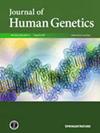A copy number variant overlapping the 3ʹUTR of PLP1 causes spastic paraplegia
IF 2.5
3区 生物学
Q2 GENETICS & HEREDITY
引用次数: 0
Abstract
Leukodystrophy presents a significant diagnostic challenge due to its varied clinical presentation and similarity to other myelin disorders, characterized by abnormalities in myelin and white matter. Hypomyelination disorders, including Pelizaeus-Merzbacher disease (PMD) and hereditary spastic paraplegias (SPG), are associated with variants in the proteolipid protein 1 (PLP1) gene, leading to symptoms ranging from severe dysmyelination in infancy to delayed dysmyelination and axonal degeneration in adulthood. Family history was taken, and pedigree was constructed. Recruitment included seven males and females with spastic paraplegia and nine healthy relatives, who were clinically investigated, and tested with molecular genetic assays including whole exome sequencing (WES), whole genome sequencing (WGS), and PCR amplification with fragment analysis on gel electrophoresis to identify and confirm the genetic cause. Family history was consistent with hereditary condition marked by progressive spastic paraplegia in 10 family members. Males had early onset and progressive paraplegia, and neurodegenerative conditions, resulting in a decline in the neurocognitive functions. However, in some females, the symptoms manifested later in their 30s–40s, leading to neurodegenerative conditions and spastic paraplegias. A total of 16 family members were available for genetic testing and segregation studies. Initial clinical WES in four members was negative. Next, WGS identified a novel copy number variant (CNV) loss (75.5 kb) involving the 3’UTR of the PLP1 gene in three members (the mother, affected son, but not in the unaffected son). Segregation studies in all 16 family members confirmed the presence of the CNV in five additional affected individuals and an asymptomatic female, but not in the eight asymptomatic individuals. Our study reports a novel 3ʹUTR CNV in PLP1 in a large family with several individuals affected with SPG. This finding expands the mutational landscape of the PLP1-related diseases to include CNV and, possibly, small sequence changes in the regulatory regions of PLP1, that would otherwise be overlooked during the interpretation of the next generation sequencing data.

与PLP1的3'UTR重叠的拷贝数变异导致痉挛性截瘫。
由于其不同的临床表现和与其他髓磷脂疾病的相似性,以髓磷脂和白质异常为特征,白质营养不良呈现出显著的诊断挑战。髓鞘发育低下疾病,包括Pelizaeus-Merzbacher病(PMD)和遗传性痉挛性截瘫(SPG),与蛋白脂蛋白1 (PLP1)基因变异有关,可导致从婴儿期严重髓鞘发育异常到成年期迟发性髓鞘发育异常和轴突变性等症状。采集家族史,建立家谱。招募7名痉挛性截瘫患者和9名健康亲属,对他们进行临床调查,并进行全外显子组测序(WES)、全基因组测序(WGS)、PCR扩增和凝胶电泳片段分析等分子遗传学检测,以确定遗传原因。家族史与10名家族成员进行性痉挛性截瘫的遗传状况一致。男性有早期发作和进行性截瘫,以及神经退行性疾病,导致神经认知功能下降。然而,在一些女性中,症状在30 -40岁时表现出来,导致神经退行性疾病和痉挛性截瘫。共有16名家庭成员可进行基因检测和分离研究。4名患者初始临床WES为阴性。接下来,WGS在三个成员(母亲,受影响的儿子,但未受影响的儿子)中发现了一种新的拷贝数变异(CNV)损失(75.5 kb),涉及PLP1基因的3'UTR。在所有16名家庭成员中进行的分离研究证实,另外5名受影响个体和1名无症状女性中存在CNV,但在8名无症状个体中没有。我们的研究报告了一个有几个SPG患者的大家庭中PLP1的3'UTR CNV。这一发现扩大了PLP1相关疾病的突变景观,包括CNV和可能的PLP1调控区域的小序列变化,否则在解释下一代测序数据时将被忽视。
本文章由计算机程序翻译,如有差异,请以英文原文为准。
求助全文
约1分钟内获得全文
求助全文
来源期刊

Journal of Human Genetics
生物-遗传学
CiteScore
7.20
自引率
0.00%
发文量
101
审稿时长
4-8 weeks
期刊介绍:
The Journal of Human Genetics is an international journal publishing articles on human genetics, including medical genetics and human genome analysis. It covers all aspects of human genetics, including molecular genetics, clinical genetics, behavioral genetics, immunogenetics, pharmacogenomics, population genetics, functional genomics, epigenetics, genetic counseling and gene therapy.
Articles on the following areas are especially welcome: genetic factors of monogenic and complex disorders, genome-wide association studies, genetic epidemiology, cancer genetics, personal genomics, genotype-phenotype relationships and genome diversity.
 求助内容:
求助内容: 应助结果提醒方式:
应助结果提醒方式:


